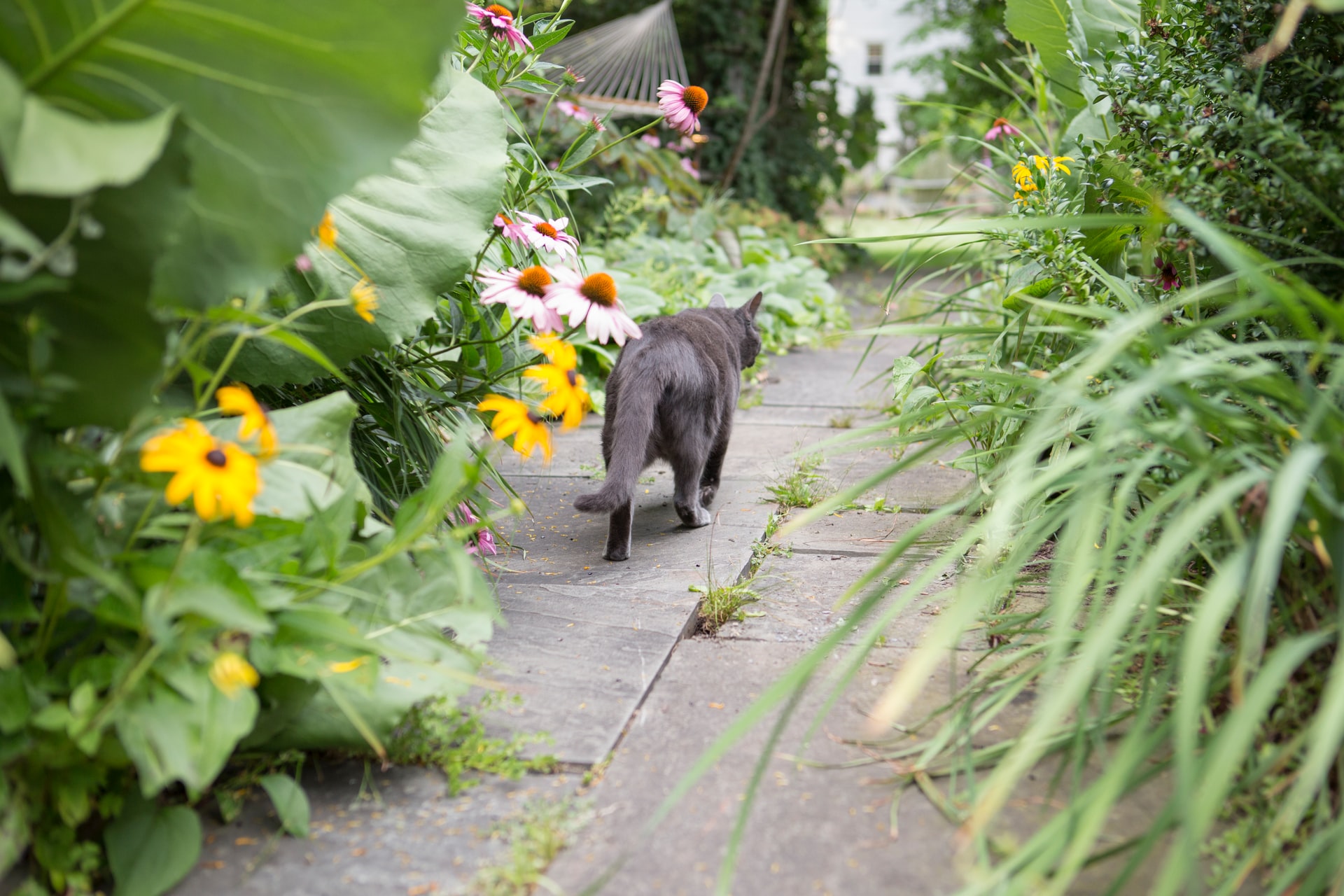Last Updated on July 12, 2021 by Fumipets
Curiosity, mating, hunting, eating, and establishing territory may lead domestic cats, feral cats, and homeless strays into your yard or garden. Some may be searching for a new location to live. Keeping cats out of your outdoor space may be difficult due to their amazing climbing and leaping skills. Examine a few effective cat repellents and methods for preventing feline invaders from using your garden as a litter box.
Different Cat Repellents
Cats can be discouraged from digging in your garden beds or pussyfooting around your property by employing a few tactics or products. Make sure to switch up your approaches on a regular basis. A new cat in the area may not be as receptive to your typical techniques, so mixing things up on a regular basis might help you get greater results.
Odour Barriers
The nose of a cat is very sensitive to scent. Because humans have 5 million odour receptors in their olfactory system, you may be sensitive to the scent of cat urine in your yard. A cat, on the other hand, has 200 million odour sensors. You may have a lot of luck keeping cats away if your yard or garden contains offensive odours.
To deter cats from entering an area, commercial cat repellents use the olfactory barrier technique. Shake-Away powder smells like predators that cats are afraid of, such as coyote, fox, and bobcat. This commercial cat repellant is in the shape of granules that you just sprinkle over the issue area. The product is non-toxic and organic, so your plants will not be harmed.
You may have heard that using commercially supplied lion excrement as a deterrent is effective; nevertheless, this technique has been disproven. The famous “Mythbusters” programme debunked the notion that it can keep cats away.
Some plants emit odours that cats despise. Coleus canina, often known as “scaredy cat plant,” is one of these plants. It’s also helpful if you want your dogs to stay away from your plants. Rue, lavender (which is also a deer-resistant plant), and pennyroyal are some plants that are suggested for keeping cats out of yards. Plant them in the same area as your other plants.
Cats are said to dislike the smells of dried blood and citrus (both of which may be present in blood meal fertiliser). In your garden, use the peels of oranges, lemons, limes, and grapefruit. Mothballs are used by certain individuals. Cayenne pepper flakes may also be used, although this is not humane since it can sting and cause pain.

Physical Obstacles
Before you plant, place physical barriers such as chicken wire on top of your soil or mulch across the planting bed. Chicken wire and bristly materials irritate cats. You may cut holes in the chicken wire big enough for your plants to be installed using wire cutters.
Use sharp-edged pine cones, holly cuttings, eggshells, or stone mulch as a mulching alternative. These tough materials will deter cats, which like to dig and defecate in loose soil. To keep cats from perching or reclining in other places, use a plastic carpet runner with the nub side up.
Although an electric wire fence may seem to be an extreme choice, there is a humane version that can keep rabbits out of your garden. Mr. McGregor Fence is a popular and safe electric wire fence that ResponsibleConsumer.net recommends.

Water Repellent
Water is another physical obstacle that cats despise like kryptonite. When you capture cats in the prohibited zone, use a Super Soaker or similar water pistol to spray them. This approach promotes the idea that they don’t belong in your garden. Because you can’t sit in your yard all day, every day, you may invest in a water gadget, such as a Scarecrow Sprinkler, that detects intruders and shoots a blast of water at them.
Sound Barriers
Cats have a far wider range of hearing than humans. Cat Stop is an electronic cat deterrence device that uses a high frequency that is inaudible to humans but very irritating to cats. It’s simple to set up. You place the gadget in front of your garden or yard. When a motion sensor senses an intruder, Cat Stop emits its high-frequency sound, frightening the cat away.
The SsssCat! repellant gadget is motion-activated and utilises sound and a sprayed repellent. You may also create a loud gadget by putting marbles or stones in an empty container and shaking it when a cat wanders over a fence. Alternatively, if a cat creates a vibration, use a sensitive bell or wind chimes to generate a noise.
Make Your Area Unattractive to Cats
Maintain a clean and clutter-free yard, garden, and property. Cleanliness may help to minimise stray and roaming cat visits.

Smells Attract Cats
Outside in your yard, do not feed your dogs or other cats. Other animals, especially cats, will be attracted to the scent of food. Clean your outdoor grill thoroughly after each use to eliminate food crumbs and reduce odours. Also, ensure that your trash containers are locked so that cats cannot dig through your garbage.
As soon as you see urine spray on the walls or doors, wash it away. Cats use urine spray to mark their territory. To remove territorial markings and avoid recurrent spraying, use an enzyme-based odour neutralizer.
Other Cat Attractors
Cats like stalking and preying. Make sure your yard isn’t a haven for animals that cats like chasing. Clear away any debris or clutter that may attract mice or other tiny prey that cats like chasing.
All openings that might lead to sheds, garages, or places under decks or porches should be boarded up. Feral cats and their prey may take shelter in any available space.
Feeder baffles and placement where cats won’t harm the birds are two ways to keep bird feeders safe.

Create a Cat-Friendly Zone.
If you don’t want the cats to go completely, but you do want them to stop destroying your yard, come to an agreement. In a tiny area of the yard, create a separate bed of catnip plants. Catnip plants aren’t for everyone, but for those who do, a catnip patch may become a secret refuge and favourite hangout.
If you build a sandbox especially for cats and put it near the catnip plants, the rest of the garden or yard will be left alone. The sandbox will attract cat faeces like a magnet. After that, you’ll have to pick up the cat faeces, but at least it’ll be in one convenient location.
Curbing the Stray Population
Your yard may attract dogs whose owners let them out, stray cats who used to have homes, and wild cats. In addition to the cat repellant and cleaning techniques, use these strategies.
Consult Your Neighbors
Collaborate with your neighbours to keep their dogs out of your yard and away from the birds you wish to save. Make it clear to your neighbours that you do not want cats in your yard. Encourage neighbours with indoor-outdoor cats to get bells and colourful collars for their cats so that birds can see them and flee. Additionally, the issue will be alleviated if the whole community works together to minimise feral cat visits.
/cat-repellents-to-keep-cats-out-of-your-yard-2132573-hero-23591eb06a8f4c909238657db9fbfb4e.jpg)
Contact the Authorities or Removal Agencies
Inquire about what you can do to prevent wandering cats if your neighbourhood has rules, ordinances, or homeowner association limitations. Find out what actions you’re authorised to do. Look for programmes that feed or care for feral cats, such as trap-neuter-release or other community-based initiatives. Support local cat shelters so that more stray cats may be cared for.
Humane Traps
When all other options have failed, check whether setting humane traps and capturing stray or feral cats is legal. Hand over stray cats to animal control or shelters. If you see the pet has tags, call the owner to pick up their pet and explain the situation.


















